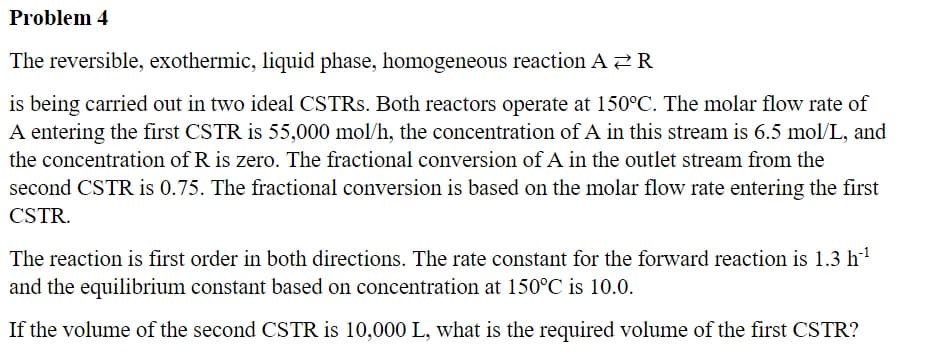The reversible, exothermic, liquid phase, homogeneous reaction AR is being carried out in two ideal CSTRs. Both reactors operate at 150°C. The molar flow rate of A entering the first CSTR is 55,000 mol/h, the concentration of A in this stream is 6.5 mol/L, and the concentration of R is zero. The fractional conversion of A in the outlet stream from the second CSTR is 0.75. The fractional conversion is based on the molar flow rate entering the first CSTR. The reaction is first order in both directions. The rate constant for the forward reaction is 1.3 h-¹ and the equilibrium constant based on concentration at 150°℃ is 10.0. If the volume of the second CSTR is 10,000 L, what is the required volume of the first CSTR?
The reversible, exothermic, liquid phase, homogeneous reaction AR is being carried out in two ideal CSTRs. Both reactors operate at 150°C. The molar flow rate of A entering the first CSTR is 55,000 mol/h, the concentration of A in this stream is 6.5 mol/L, and the concentration of R is zero. The fractional conversion of A in the outlet stream from the second CSTR is 0.75. The fractional conversion is based on the molar flow rate entering the first CSTR. The reaction is first order in both directions. The rate constant for the forward reaction is 1.3 h-¹ and the equilibrium constant based on concentration at 150°℃ is 10.0. If the volume of the second CSTR is 10,000 L, what is the required volume of the first CSTR?
Introduction to Chemical Engineering Thermodynamics
8th Edition
ISBN:9781259696527
Author:J.M. Smith Termodinamica en ingenieria quimica, Hendrick C Van Ness, Michael Abbott, Mark Swihart
Publisher:J.M. Smith Termodinamica en ingenieria quimica, Hendrick C Van Ness, Michael Abbott, Mark Swihart
Chapter1: Introduction
Section: Chapter Questions
Problem 1.1P
Related questions
Question

Transcribed Image Text:Problem 4
The reversible, exothermic, liquid phase, homogeneous reaction A ₹R
is being carried out in two ideal CSTRs. Both reactors operate at 150°C. The molar flow rate of
A entering the first CSTR is 55,000 mol/h, the concentration of A in this stream is 6.5 mol/L, and
the concentration of R is zero. The fractional conversion of A in the outlet stream from the
second CSTR is 0.75. The fractional conversion is based on the molar flow rate entering the first
CSTR.
The reaction is first order in both directions. The rate constant for the forward reaction is 1.3 h-¹
and the equilibrium constant based on concentration at 150°C is 10.0.
If the volume of the second CSTR is 10,000 L, what is the required volume of the first CSTR?
Expert Solution
This question has been solved!
Explore an expertly crafted, step-by-step solution for a thorough understanding of key concepts.
This is a popular solution!
Trending now
This is a popular solution!
Step by step
Solved in 2 steps

Recommended textbooks for you

Introduction to Chemical Engineering Thermodynami…
Chemical Engineering
ISBN:
9781259696527
Author:
J.M. Smith Termodinamica en ingenieria quimica, Hendrick C Van Ness, Michael Abbott, Mark Swihart
Publisher:
McGraw-Hill Education

Elementary Principles of Chemical Processes, Bind…
Chemical Engineering
ISBN:
9781118431221
Author:
Richard M. Felder, Ronald W. Rousseau, Lisa G. Bullard
Publisher:
WILEY

Elements of Chemical Reaction Engineering (5th Ed…
Chemical Engineering
ISBN:
9780133887518
Author:
H. Scott Fogler
Publisher:
Prentice Hall

Introduction to Chemical Engineering Thermodynami…
Chemical Engineering
ISBN:
9781259696527
Author:
J.M. Smith Termodinamica en ingenieria quimica, Hendrick C Van Ness, Michael Abbott, Mark Swihart
Publisher:
McGraw-Hill Education

Elementary Principles of Chemical Processes, Bind…
Chemical Engineering
ISBN:
9781118431221
Author:
Richard M. Felder, Ronald W. Rousseau, Lisa G. Bullard
Publisher:
WILEY

Elements of Chemical Reaction Engineering (5th Ed…
Chemical Engineering
ISBN:
9780133887518
Author:
H. Scott Fogler
Publisher:
Prentice Hall


Industrial Plastics: Theory and Applications
Chemical Engineering
ISBN:
9781285061238
Author:
Lokensgard, Erik
Publisher:
Delmar Cengage Learning

Unit Operations of Chemical Engineering
Chemical Engineering
ISBN:
9780072848236
Author:
Warren McCabe, Julian C. Smith, Peter Harriott
Publisher:
McGraw-Hill Companies, The